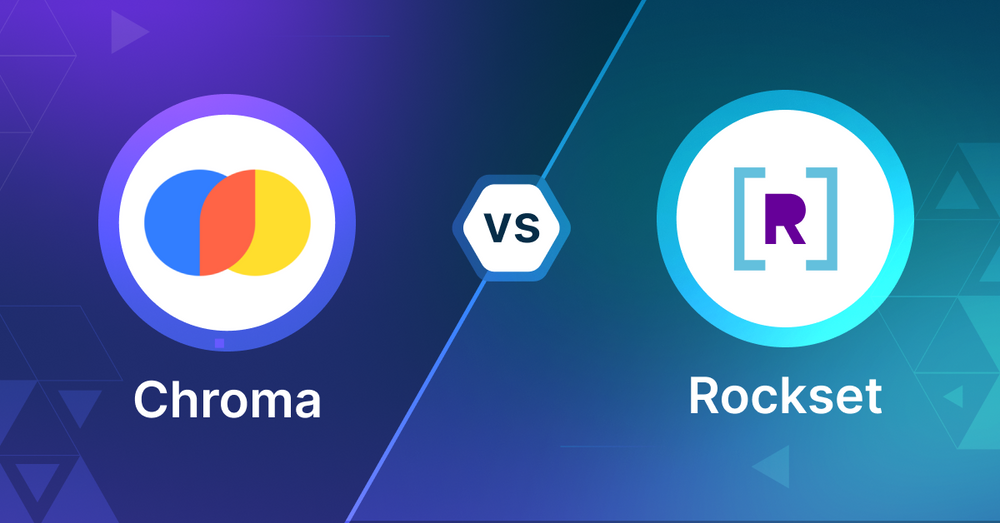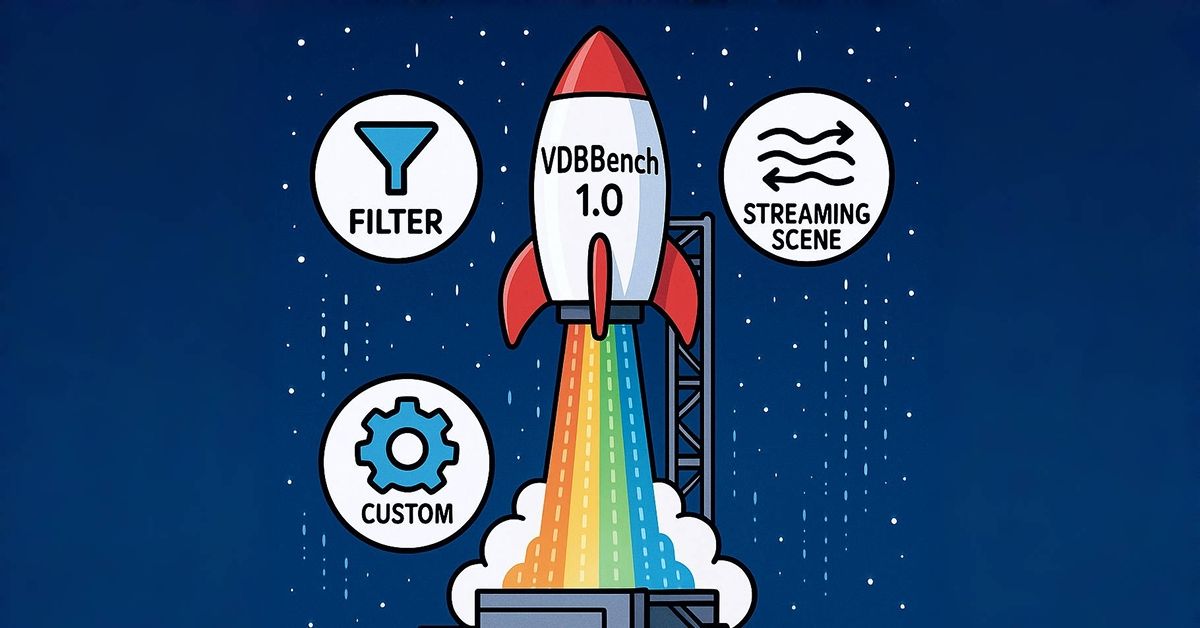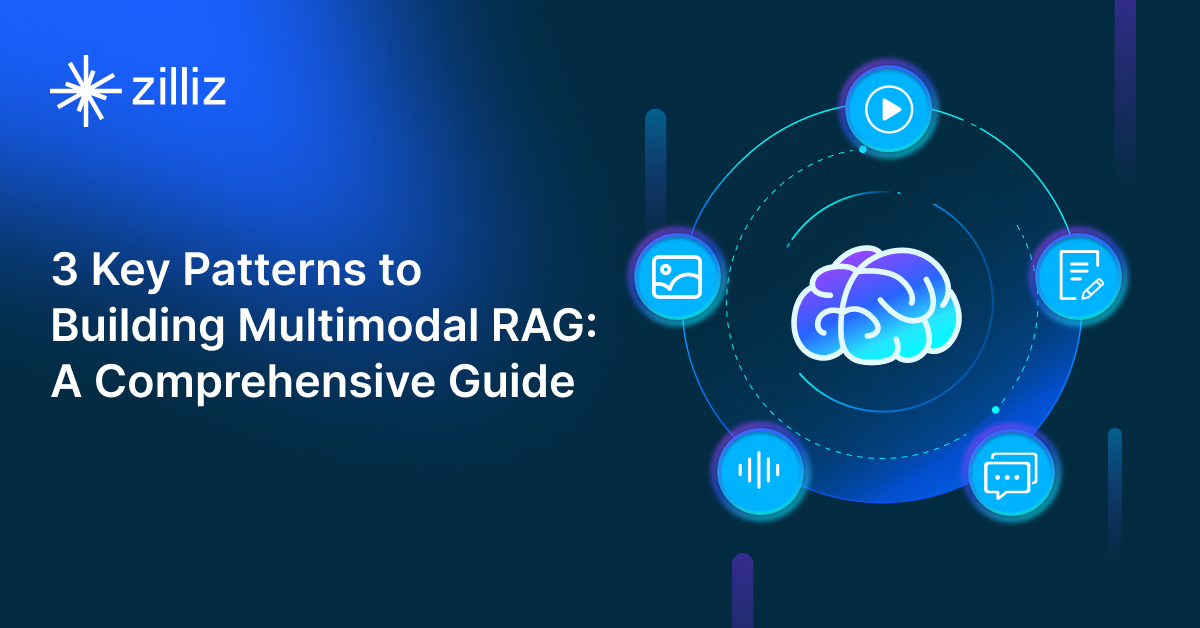Chroma vs Rockset: Choosing the Right Vector Database for Your AI Applications

As AI-driven applications become more prevalent, developers and engineers face the challenge of selecting the right database to handle vector data efficiently. Two popular options in this space are Chroma and Rockset. This article compares these technologies to help you make an informed decision for your vector database needs.
What is a Vector Database?
Before we compare Chroma and Rockset, let's first explore the concept of vector databases. A vector database is specifically designed to store and query high-dimensional vectors, which are numerical representations of unstructured data. These vectors encode complex information, such as text's semantic meaning, images' visual features, or product attributes. By enabling efficient similarity searches, vector databases play a pivotal role in AI applications, allowing for more advanced data analysis and retrieval.
Vector databases are adopted in many use cases, including e-commerce product recommendations, content discovery platforms, anomaly detection in cybersecurity, medical image analysis, and natural language processing (NLP) tasks. They also play a crucial role in Retrieval Augmented Generation (RAG), a technique that enhances the performance of large language models (LLMs) by providing external knowledge to reduce issues like AI hallucinations.
There are many types of vector databases available in the market, including:
Purpose-built vector databases such as Milvus, Zilliz Cloud (fully managed Milvus)
Lightweight vector databases such as Chroma and Milvus Lite.
Traditional databases with vector search add-ons capable of performing small-scale vector searches.
Chroma and Rockset represent different approaches to vector databases. Cassandra is a traditional database that has evolved to include vector search capabilities and Vald, on the other hand, is a purpose-built vector database. It was designed from the ground up to handle vector data and perform similarity searches efficiently. As a specialized solution, Vald focuses exclusively on vector operations and is optimized for tasks like similarity search and recommendations.
What is Chroma? An Overview
Chroma is an open-source, AI-native vector database that simplifies the process of building AI applications. It acts as a bridge between large language models (LLMs) and the data they require to function effectively. Chroma's main objective is to make knowledge, facts, and skills easily accessible to LLMs, thereby streamlining the development of AI-powered applications. At its core, Chroma provides tools for managing vector data, allowing developers to store embeddings (vector representations of data) along with their associated metadata. This capability is crucial for many AI applications, as it enables efficient similarity searches and data retrieval based on vector relationships.
One of Chroma's key strengths is its focus on simplicity and developer productivity. The team behind Chroma has prioritized creating an intuitive interface that allows developers to quickly integrate vector search capabilities into their applications. This emphasis on ease of use doesn't come at the cost of performance. Chroma is designed to be fast and efficient, making it suitable for a wide range of applications. It operates as a server and offers first-party client SDKs for both Python and JavaScript/TypeScript, providing flexibility for developers to work in their preferred programming environment.
Chroma's functionality revolves around the concept of collections, which are groups of related embeddings. When adding documents to a Chroma collection, the system can automatically tokenize and embed them using a specified embedding function, or a default one if not provided. This process transforms raw data into vector representations that can be efficiently searched. Along with the embeddings, Chroma allows storage of metadata for each document, which can include additional information useful for filtering or organizing data. Chroma provides flexible querying options, allowing searches for similar documents using either vector embeddings or text queries, returning the closest matches based on vector similarity.
Chroma stands out in several ways. Its API is designed to be intuitive and easy to use, reducing the learning curve for developers new to vector databases. It supports various types of data and can work with different embedding models, allowing users to choose the best approach for their specific use case. Chroma is built to integrate seamlessly with other AI tools and frameworks, making it a good fit for complex AI pipelines. Additionally, Chroma's open-source nature (licensed under Apache 2.0) provides transparency and the potential for community-driven improvements and customizations. The Chroma team is actively working on enhancements, including plans for a managed service (Hosted Chroma) and various tooling improvements, indicating a commitment to ongoing development and support.
What is Rockset? An Overview
Rockset is a real-time search and analytics database designed to handle both structured and unstructured data, including vector embeddings. Its core strength lies in its ability to ingest, index, and query data in real-time, making it suitable for applications that require up-to-the-second insights. Rockset supports both streaming and bulk data ingestion, with the ability to process high-velocity event streams and change data capture (CDC) feeds within 1-2 seconds. One of Rockset's key features is its Converged Indexing technology, built on mutable RocksDB. This allows for in-place updates of vectors and metadata, making it highly efficient for scenarios where data frequently changes. Rockset can handle document sizes up to 40MB and supports vector dimensionality of up to 200,000, making it suitable for a wide range of vector embedding applications. Rockset integrates vector search capabilities as part of its core functionality. It supports both K-Nearest Neighbors (KNN) and Approximate Nearest Neighbors (ANN) search methods, using a distributed FAISS index for scalability. Rockset's approach is algorithm-agnostic, allowing for flexibility in search implementations. Its cost-based optimizer can dynamically choose between KNN and ANN search methods for optimal efficiency. What sets Rockset apart in terms of vector search is its Converged Index, which combines search, ANN, columnar, and row indexes into a single structure. This allows for efficient handling of a wide range of query patterns out of the box. Rockset also supports metadata filtering and hybrid search, with its optimizer determining the most efficient query execution path. It can perform searches across multiple ANN fields, supporting multi-modal models, and offers both SQL and REST APIs for query interface flexibility.
Key Differences
Search Methodology
Chroma focuses on vector similarity search, which is crucial for AI applications. It allows searches for similar documents using either vector embeddings or text queries, returning the closest matches based on vector similarity. Chroma's approach is tailored for AI-centric workflows, particularly those involving large language models. Rockset, on the other hand, supports both K-Nearest Neighbors (KNN) and Approximate Nearest Neighbors (ANN) search methods, using a distributed FAISS index for scalability. Rockset's approach is algorithm-agnostic, allowing for flexibility in search implementations. Its cost-based optimizer can dynamically choose between KNN and ANN search methods for optimal efficiency, making it suitable for a wider range of applications beyond AI-specific use cases.
Data Handling
Chroma specializes in managing vector data and associated metadata. It can automatically tokenize and embed documents using a specified or default embedding function, transforming raw data into vector representations. This process is optimized for AI applications that rely on vector embeddings. Rockset, in contrast, is designed to handle both structured and unstructured data, including vector embeddings. It supports streaming and bulk data ingestion, processing high-velocity event streams and change data capture (CDC) feeds within 1-2 seconds. Rockset's Converged Indexing technology, built on mutable RocksDB, allows for in-place updates of vectors and metadata, making it highly efficient for scenarios where data frequently changes. It can handle document sizes up to 40MB and supports vector dimensionality of up to 200,000, offering more flexibility in terms of data types and sizes.
Scalability and Performance
While Chroma is designed to be fast and efficient, making it suitable for a wide range of applications, specific details about its scalability strategies are not provided in the given information. Rockset, however, offers clear scalability advantages. Its distributed FAISS index allows for scalable vector search operations. The Converged Index technology combines search, ANN, columnar, and row indexes into a single structure, enabling efficient handling of a wide range of query patterns out of the box. This approach, coupled with Rockset's ability to ingest and process data in real-time, suggests strong performance capabilities for large, frequently updating datasets.
Flexibility and Customization
Chroma provides flexibility in terms of data types and embedding models, allowing users to choose the best approach for their specific use case. Its API is designed to be intuitive and easy to use, offering flexible querying options. Rockset appears to offer more extensive customization options. Its algorithm-agnostic approach to vector search allows for flexibility in search implementations. Rockset supports metadata filtering and hybrid search, with its optimizer determining the most efficient query execution path. It can perform searches across multiple ANN fields, supporting multi-modal models, and offers both SQL and REST APIs for query interface flexibility.
Integration and Ecosystem
Chroma is built to integrate seamlessly with other AI tools and frameworks, making it a good fit for complex AI pipelines. It offers first-party client SDKs for both Python and JavaScript/TypeScript, providing flexibility for developers to work in their preferred programming environment. Rockset has support for both SQL and REST APIs suggests potential for integration with a wide range of data processing and analytics tools, possibly extending beyond the AI-specific focus of Chroma.
Ease of Use
Chroma emphasizes simplicity and developer productivity, with an intuitive interface that allows developers to quickly integrate vector search capabilities into their applications. This focus on ease of use aims to reduce the learning curve for developers new to vector databases. Rockset has SQL support which addresses its ease of use and less of a learning curve which might make it accessible to a wider range of developers.
Cost Considerations
Chroma is open-source and free to use, which can be advantageous for startups and smaller projects. The Chroma team has mentioned plans for a managed service (Hosted Chroma), but specific pricing details are not provided.
When to Choose Chroma
Chroma is ideal for AI-centric applications relying on vector similarity search and embedding management. It's well-suited for projects integrating vector search capabilities with large language models (LLMs) or AI frameworks. Choose Chroma for applications requiring efficient storage and retrieval of vector embeddings, such as semantic search engines or recommendation systems. Its strength lies in simplicity and optimization for AI workflows, making it perfect for developers seeking quick vector search implementation. Chroma is great for startups, research projects, or teams building specialized AI tools without need for extensive real-time analytics or complex querying beyond vector operations.
When to Choose Rockset
Rockset is preferable for applications requiring real-time search and analytics across various data types, including vector embeddings. Choose Rockset for handling high-velocity data streams, performing complex queries on structured and unstructured data, and needing up-to-the-second insights. It's suitable for use cases involving frequently changing data, thanks to its in-place updates of vectors and metadata. Rockset excels in scenarios combining traditional database operations with vector search, like real-time dashboards or log analytics. It's ideal when you need flexibility in query interfaces (SQL and REST API) and search methodologies (KNN and ANN). Consider Rockset for IoT data analysis, real-time monitoring systems, or applications requiring hybrid searches combining vector similarity with metadata filtering.
Conclusion
In conclusion, Chroma and Rockset offer powerful capabilities for managing and querying vector data, excelling in different areas. Chroma is optimized for AI-centric workflows, ideal for developers working with large language models and requiring efficient vector similarity search. Rockset excels in versatility and real-time analytics, handling diverse data types and offering complex querying options. The choice between these technologies should be driven by your project's specific requirements. Consider factors such as primary use case, data types, need for real-time analytics, scale of vector operations, and your broader ecosystem of tools. Chroma may be better for specialized AI applications, while Rockset could be preferable for diverse, real-time data processing needs. Your decision should align with performance needs, development workflow, and long-term scalability requirements.
When to Choose a Specialized Vector Database?
While Chroma and Rockset offer vector search capabilities, they are not optimized for large-scale, high-performance vector search tasks. If your application relies on fast, accurate similarity searches over millions or billions of high-dimensional vectors, such as in image recognition, e-commerce recommendations, or NLP tasks, specialized vector databases like like Milvus and Zilliz Cloud (the managed Milvus) are a better fit. These databases are built to handle vector data at scale, using advanced Approximate Nearest Neighbor (ANN) algorithms (e.g., HNSW, IVF ) and offering advanced features like hybrid search (including hybrid sparse and dense search, multimodal search, vector search with metadata filtering, and hybrid dense and full-text search), real-time ingestion, and distributed scalability for high-performance in dynamic environments.
On the other hand, general-purpose systems like Chroma or Rockset are suitable when vector search is not the primary focus, and you’re handling structured or semi-structured data with smaller vector datasets or moderate performance requirements. If you already use these systems and want to avoid the overhead of introducing new infrastructure, vector search plugins can extend their capabilities and provide a cost-effective solution for simpler, lower-scale vector search tasks.
Using Open-source VectorDBBench to Evaluate and Compare Vector Databases on Your Own
VectorDBBench is an open-source benchmarking tool designed for users who require high-performance data storage and retrieval systems, particularly vector databases. This tool allows users to test and compare the performance of different vector database systems such as Milvus and Zilliz Cloud (the managed Milvus) using their own datasets and determine the most suitable one for their use cases. Using VectorDBBench, users can make informed decisions based on the actual vector database performance rather than relying on marketing claims or anecdotal evidence.
VectorDBBench is written in Python and licensed under the MIT open-source license, meaning anyone can freely use, modify, and distribute it. The tool is actively maintained by a community of developers committed to improving its features and performance.
Download VectorDBBench from its GitHub repository to reproduce our benchmark results or obtain performance results on your own datasets.
Take a quick look at the performance of mainstream vector databases on the VectorDBBench Leaderboard.
Read the following blogs to learn more about vector database evaluation.
Further Resources about VectorDB, GenAI, and ML
- What is a Vector Database?
- What is Chroma? An Overview
- What is Rockset? An Overview
- Key Differences
- When to Choose Chroma
- When to Choose Rockset
- Conclusion
- When to Choose a Specialized Vector Database?
- Using Open-source VectorDBBench to Evaluate and Compare Vector Databases on Your Own
- Further Resources about VectorDB, GenAI, and ML
Content
Start Free, Scale Easily
Try the fully-managed vector database built for your GenAI applications.
Try Zilliz Cloud for FreeKeep Reading

Announcing VDBBench 1.0: Open-Source VectorDB Benchmarking with Your Real-World Production Workloads
VDBBench 1.0 offers an open-source benchmarking solution for vector databases, emphasizing real-world production conditions, including streaming data and concurrent workloads.
Milvus/Zilliz + Surveillance: How Vector Databases Transform Multi-Camera Tracking
See how Milvus vector database enhances multi-camera tracking with similarity-based matching for better surveillance in retail, warehouses and transport hubs.

3 Key Patterns to Building Multimodal RAG: A Comprehensive Guide
These multimodal RAG patterns include grounding all modalities into a primary modality, embedding them into a unified vector space, or employing hybrid retrieval with raw data access.
The Definitive Guide to Choosing a Vector Database
Overwhelmed by all the options? Learn key features to look for & how to evaluate with your own data. Choose with confidence.